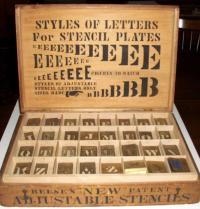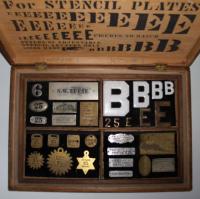The first U.S. patent (no. 1,767) for “settable-unit stencils” was filed in 1840 by Edwin Allen, who designed stencils of individual letters that could be joined together to form words. This and other U.S. patents can be read at www.uspto.gov.
Samuel Widdows Reese (1843-1913) was a veteran, who served in the 1st Pennsylvania Reserve Cavalry. After the war, he moved to Chicago where he is listed in the city directory as a stencil cutter. Reese filed his first patent for a series of adjustable stencil letters in June 1873 (no. 148,087) and filed a second in 1876 for stencils with an S-fold on one edge to lock together with adjacent letters. The stencils were “machine-cut in spring brass with steel dies”. A broadside advertised Reese’s stencils
for shippers in marking merchandise and produce … manufacturers for labelling contents on boxes … merchants and real estate men in making signs and bulletin boards … cheese factors for dating cheese … in fact nearly all classes find them useful, profitable and desirable.
1876 was also the year his firm S.W. Reese and Company opened in Chicago, where one could buy stencils, badges, and other sign-making equipment. Although the company continued to operate under Reese’s name, he left it in the hands of his partner Christian Hanson (1843-1914) and moved to New York City. A second business called Reese and Company was established on Pearl Street in Manhattan, where it remained until late in the twentieth-century. So successful was the Reese interlocking stencil design that it is still used today.
See Eric Kindle, “Patents Progress: the Adjustable Stencil,” Journal of the Printing Historical Society no. 9 (Spring 2006): 65-93
and
Eric Kindle “Recollecting Stencil Letters,” Typography Papers 5 (Reading, 2003)


